Planer: what is it and which one is better to choose?

During the performance of any carpentry work, you cannot do without a specialized tool. Masters of this direction constantly use a plane, a jointer, a scherhebel. Despite the development of the technological process and the production of new devices for the manufacture of goods from wood, it is almost impossible to do without a plane.


What it is?
A plane is called a planer for processing wood, which is used during carpentry and joinery work. Its use is directed towards the acquisition of the surface the desired shape and straight lines. With this device, workpieces are processed according to the established parameters, all kinds of joinery connections are made.
Although main purpose of the plane - this is the planing of wood, the elimination of irregularities, roughness and all kinds of defects on it, it has found other applications. The tool is also used for plastering, flooring, chamfering, edging, and sanding cars.
Aerated concrete planer and other types look like a simple device with a flat sole and block.
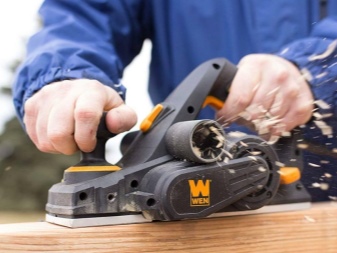

If the design of the plane allows, then they can perform the following work:
- chamfering;
- creating grooves on blanks;
- material processing, as well as its adjustment to the required dimensions;
- sampling a quarter;
- obtaining protrusions on the edges of the tree.


Finishing material can be done with a plane that is designed for grinding. If an electric tool has the ability to use different knives, then the functionality of the device will be wide. Setting up the plane is quite simple - to do this, you need to set the height of the exit from the open part of the blade relative to the sole.
If the gaps are large enough, the wood fibers are damaged. For extending knives it is worth making the mount weaker by hammering it down with a mallet.
The beginning of the use of this tool was recorded in ancient times, in this regard, we can conclude that, both earlier and now, craftsmen cannot do without a plane when working with wood blanks.


Device
The structure of the plane is not characterized by complexity. The tool consists of the following elements:
- sole or body part;
- cutter;
- wedge;
- a slot for freeing shavings;
- incisor clamp;
- cut depth regulator;
- horn (front handle);
- stop (rear handle).

The main part of the structure of the joinery is considered cutter. It is a cutting element that looks like a sharpened plate. The location of the blade is at a given angle relative to the surface that is being processed. The presence of a regulator allows you to move the knife to a specific distance. This feature of the tool contributes to the ability to adjust the depth of cut, as well as the thickness of the chip removal.
In a factory-made planer, the sharpening of the blade is standard... The function of the front handle is direction control. Often the horn has a curved shape, so you get a good grip on the object. Rear handle purpose - this is an emphasis that creates the necessary effort for the procedure.
The sole material can be of several types - for example, metal and wood. Each material has its own pros and cons.

How is it different from a jointer?
Some inexperienced craftsmen may confuse a plane with a jointer, but there is still a difference between these objects. Jointer is called a manual type of plane, which has 2 incisors. The main purpose of this device is a precise finishing, as well as leveling surfaces with large dimensions under the ruler. The quality of the procedure is achieved due to the elongated last and edges.
The difference between a planer and a jointer also in that the block of the second is usually several times larger than the block of the first.
The jointer knife contains the chip material and the handle, which simplifies the work with the tool. The difference between these devices is also observed in the number of blades: the planer has one, and the jointer has a pair.

Species overview
Despite the simplicity of the components, currently there is more than a dozen varieties of planer... Devices made of wood and metal are conventionally divided into general purpose category, clean look machining and curly carving.
When the master has decided on the purpose of purchasing a plane, he can choose edging, end, trimming, roughing, painting, grinding, large stationary tool or any other.
Also on sale there is an end tool for metal, bodywork, carpentry, with a double knife.



Planing
Planers of this type are of the following types.
- Manual single. The tool is used to flatten the wood surface to obtain a perfect surface. The device has a straight blade with a slightly rounded edge. The absence of sharp corners prevents the formation of grooves. Thanks to a single plane, craftsmen can easily correct rough work after a saw or an ax.

- Double. The design of this device is very similar to a single plane. The presence of an additional knife breaks the chips. It is used for finishing alignments in order to achieve a surface with perfect evenness. After using the double planer, sanding is usually not required.

- Scherhebel. The device is equipped with rounded blades that are fixed at an angle of 45 degrees. Due to the oval-shaped edge, planing can be carried out across the grain. The features of the device also include the presence of a wide gap that removes the chips. Scherhebel is a great option for rough processing. Its use is aimed at the rapid elimination of chips, as a result of which the surface is rough and jagged, therefore further processing will be required.

- Grinder. This type of device is equipped with a blade that is located at an angle of 50 degrees. The planer also has a double blade and a chipbreaker. As a result of the work carried out to remove the wooden coating, the surface is smooth, which does not require additional processing. Using a sander is appropriate after working on wood with any rough tools. The purpose of this device is to bring the material to perfect smoothness.

- The jointer is designed for finishing. It is used for chip removal on large surfaces. The tool has a long block, therefore, it removes the elements of the tree that protrude. The craftsmen noticed that the longer the jointer has, the better the quality of the work is. This tool is often found in workshops that carry out professional woodworking.

- Tsinubel equipped with a single serrated knife, which is necessary for creating a grooved coating. Used for subsequent gluing of blanks. After preparing two wood elements with a cinubel, a larger contact area can be made.

- Rough... This plane is characterized by a lot of differences from the classic look. It has a metal grater sole.This tool does not have a knife, so it is used to flatten the ends on drywall. Thanks to the grater, defects that appeared during the cutting of the drywall sheet are eliminated.

Figured planing
This category of tools is used during the manufacture of grooves, processing protruding parts, edges. Despite the fact that many craftsmen use electrical devices in their work, figure planers are still popular.
- Zenzubel looks like a narrow plane, which is needed to select a quarter. Due to the minimum width of the device, the end face of the workpieces is removed, as a result of which a groove is obtained. There are several modifications of this device, with which the master can work both along and across the fiber. Often, the zenzubel is chosen for finishing procedures, which are aimed at forming coarse wrappers.

- Tongue and groove. The specialized tool has a double sole. The first block is necessary in order to guide the trajectory of movement, and the second block holds the blade on itself. The tool can be adjusted by changing the distance between the pads. Thus, the distance to the cutting edge is adjusted.

- Federgubel. This end tool is used to process longitudinal projections on the workpieces. The device has a special blade shape, the rise of which is located in the center. After processing the end part of the board, a longitudinal tenon is obtained, which is used for gluing with another part.

- Kalevka are referred to as unusual types of planers, thanks to her, workpieces are figuratively processed. This tool is indispensable in the manufacture of a cornice, baguette or doorway. The molding has a stepped sole, which is mirrored to the workpiece.

- Falzgebel is a highly specialized plane. Its application forms a strip at the edge of the workpiece without advance markings. The sole of this tool is similar to a kale.
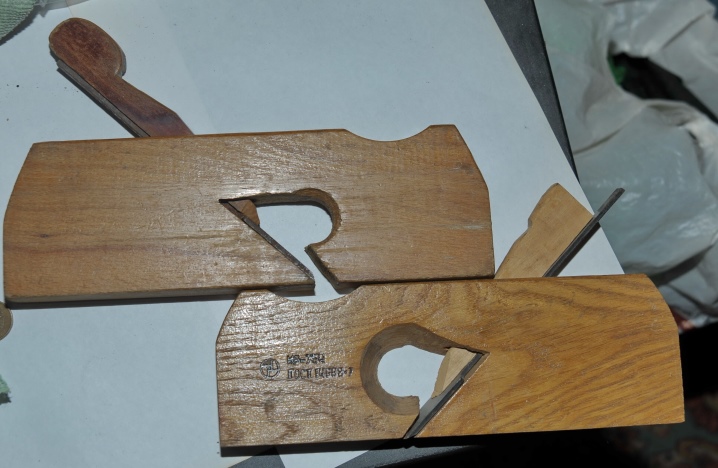
- Stap. This small hand-type planer is essential for rounding the edge. The recess is rounded at the tool blade. The sole of the device has a concave appearance. Thanks to the design features of the sole and the knife, the craftsman can make a rounded butt end.

Popular models
Since there shouldn't be any difficulties when choosing a hand planer, craftsmen should know for what electric tool models attention should be paid. According to the reviews of experts and consumers, good build quality and functionality are characterized by Japanese and German electric planers.
Products from Makita, DeWalt, Skil, Bosch, Hitachi are quite in demand.
In the rating of the best tools of this type, you can find the following models.
- Interskol R-82/650... This is a powerful domestic planer, which will come in handy in solving many everyday tasks. The tool makes even and clean cuts of wood, and also intelligently organizes the ejection of shavings. With such a device, you can perform simple repair and construction work. The plane of this model does not have many functions, but it is able to work for a long time without overheating.
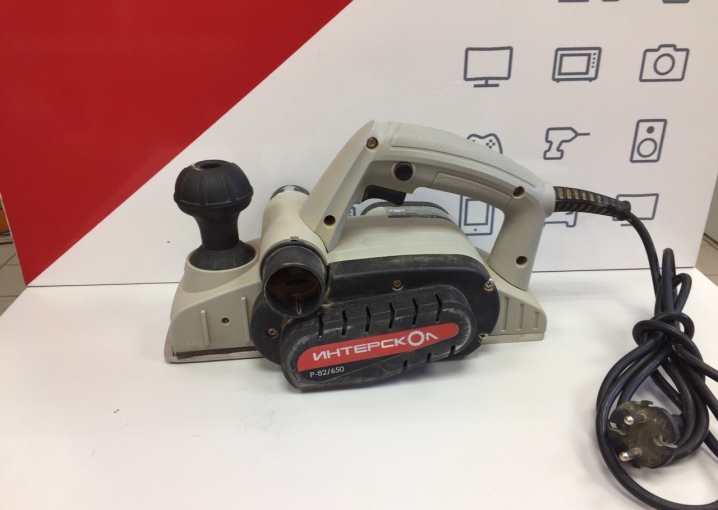
- "Whirlwind" R-82/1100 - a tool with good power, light weight, high-quality assembly and a high level of safety. This new tool in the world of tools easily copes with the tasks assigned and at the same time is inexpensive.

- Bort BFB-850-T. A compact, lightweight attachment designed for short-term work. The tool combines power and good functionality. This robust planer has a decent package and is fairly easy to use. However, during prolonged operation, the gearbox heats up at the plane.
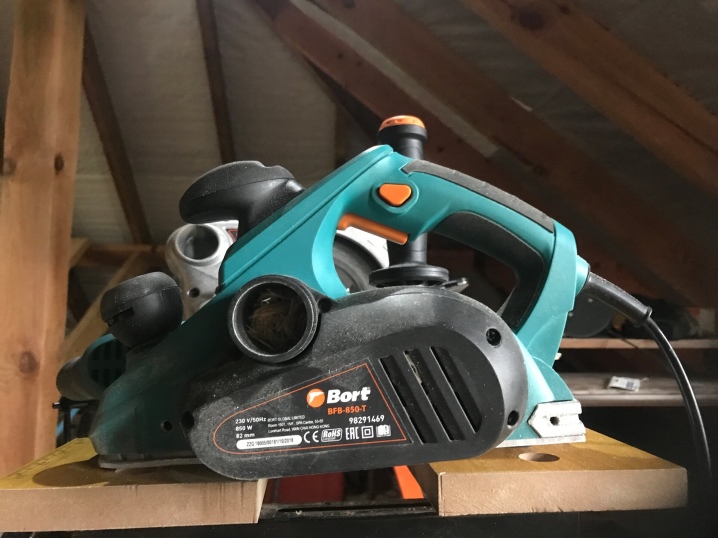
- Hammer RNK600. Lightweight, compact, handy model of a planer is great for the workshop at home. The tool is characterized by quality, good functionality, and low cost. Of the shortcomings, users note a small cord length, as well as a small sampling depth.Hammer RNK600 is not suitable for serious roughing work, but it is simply irreplaceable for the initial processing of material.

- Zubr ZR-950-82 Is a powerful functional planer that can work with any hardness of wood. The device is characterized by the presence of high quality components, as well as high build quality. The powerful planer is protected from overheating, so it can cope with the large volume of work on private construction sites.

- Bosch PHO 1500... The model is well suited for home and summer cottages. Despite the low engine power, the plane copes well with the processing of dry wood of different densities. The tool is considered universal, as it has a wide range of functions. An inexpensive and compact planer is capable of handling small jobs well.


- DeWALT DW680... The balanced electric planer is lightweight and compact. With rather modest dimensions, the tool is characterized by high power. The fixture handles hardwood with ease. The DeWALT DW680 design allows precise control of the cutting depth. The plane is suitable for domestic use when working with small workpieces.

- Rebit IE-5708C. This model of a planer can be used as a manual or stationary device. The presence of high revs, as well as a powerful engine allows it to cope with such complex types of wood as oak, acacia.

- Makita 1911. A simple and reliable planer with a large number of functions can be used by the master for a long time without the threat of overheating. This hardy tool is not recommended for working with hard types of wood.

- DeWALT Is a powerful versatile tool that has a well-thought-out design. They can do delicate work as well as planing hard wood. The advantages of the model include low weight, good performance, and advanced functionality. The disadvantage of the device, users call the lack of a soft start, the lack of implementation of maintaining speed during loads. This plane can be called a worthy example of functionality and versatility.

Among the hand planers, the following models deserve attention.
- Pinie Classic 3-48C / S. This is a comfortable model of a classic wooden plane. It is characterized by comfortable grips, a flat sole and an affordable cost.

- Topex 140mm 11A314. Despite the high cost of the tool, consumers are satisfied with its functionality. The plane removes the chips in one long strip.

- Pinie Zinubel 45mm 9-45... This plane is considered the best option in terms of cost and quality. The tool has a smooth, well-glued last and a high-quality metal part. An excellent option for a carpentry home workshop.

- Stanley 1-12-020 is a solid iron plane made in the USA. In addition to its robust construction, it is also characterized by its compact dimensions. The tool is considered suitable for any kind of crosscutting work.

- Sparta 210805 355x60 mm... This budget model of planers is produced by a German manufacturer. The tool is durable and affordable. With the help of this device, the master will be able to cope with various simple carpentry works that are aimed at leveling the surface.

- Kraftool 18841 refers to a good all-round roughing planer. This mechanical device does an excellent job of primary processing of soft wood. It is also used for processing the edges of chipboard, plastic, drywall. A durable and lightweight planer can be used for cladding walls and ceilings with plasterboard, fiberboard, chipboard.

How to choose?
Wood craftsmen often wonder which planer is best for use at home and at work. When buying a tool, you should pay attention to the following features.
- Sole. It should be characterized by evenness, absence of damage, chips, drops.
- Blade in the plane must be properly fixed, while backlashes must be absent. The best material for making an element is hardened steel. The edges must not be damaged during sharpening.
- Lever... It must be selected in accordance with your palm. It should be comfortable for the master to work with the plane. It is not worth buying a high quality tool that is inconvenient to use.
- Manufacturer... According to experts, planers are considered the best, which were made in Soviet times, since they are characterized by high quality workmanship and good characteristics of the knife. Such modern brands of planers as Stanley, Sigma, Zubr, Irwin, Sparta, Bailey, Handyman have proven themselves well. According to consumer reviews, Indian tool manufacturer Groz should not be preferred as it can be inconvenient and of poor quality.
- Body material. The choice of metal or wood is up to the master himself. Often consumers choose wooden planers, but they are not so easy to find.
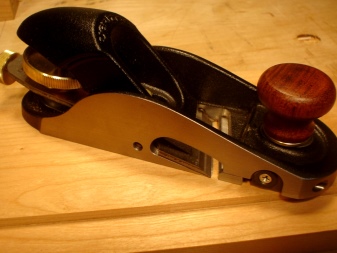

Hand planer - this is a fairly popular tool today, so many manufacturers produce it. This device can have a different purpose, quality, and functionality. Before buying a planer, you should decide on purpose of purchase, as well as functionsto be performed by the tool.
Practice shows that the best planers are not cheap, but simple devices may need to be fine-tuned.


An overview of the Enkor RE-780/82 electric plane is presented in the following video.













The comment was sent successfully.